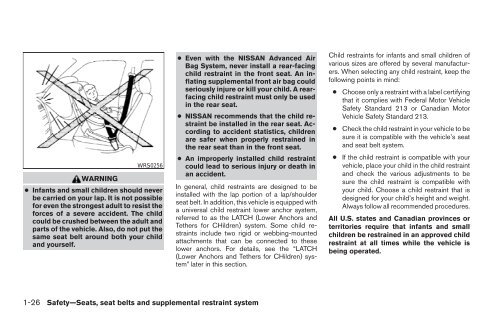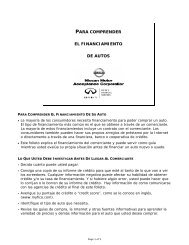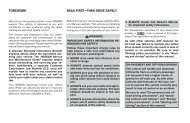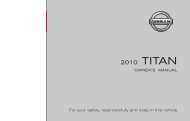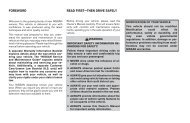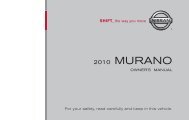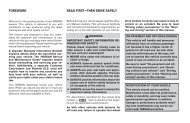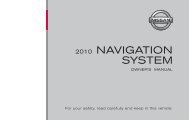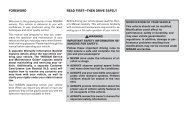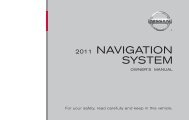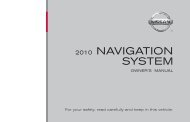- Page 1 and 2: FOREWORD READ FIRST—THEN DRIVE SA
- Page 3: NISSAN CUSTOMER CARE PROGRAM NISSAN
- Page 7 and 8: 0 Illustrated table of contents Air
- Page 9 and 10: EXTERIOR FRONT LII0013 1. Engine ho
- Page 11 and 12: PASSENGER COMPARTMENT LII0064 1. DV
- Page 13 and 14: 18. Rear sonar system off switch (i
- Page 15 and 16: WARNING/INDICATOR LIGHTS Warning li
- Page 17 and 18: 1 Safety—Seats, seat belts and su
- Page 19 and 20: Forward and backward Pull the lever
- Page 21 and 22: FRONT POWER SEAT ADJUSTMENT (if so
- Page 23 and 24: Reclining LRS0625 WARNING ● After
- Page 25 and 26: ● Do not attach anything to the h
- Page 27 and 28: ● If the head restraints are remo
- Page 29 and 30: Folding the 3rd row bench seat WARN
- Page 31 and 32: WARNING ● Do not unfasten the rea
- Page 33 and 34: WARNING SSS0014 ● Always route th
- Page 35 and 36: have a label certifying that it com
- Page 37 and 38: Unfastening the seat belts �1 To
- Page 39 and 40: ● If the rear center seat belt co
- Page 41: SEAT BELT EXTENDERS If, because of
- Page 45 and 46: LRS0616 Front Facing — step 3 �
- Page 47 and 48: LRS0619 Rear Facing — step 3 �3
- Page 49 and 50: LRS0358 Front Facing (center) — s
- Page 51 and 52: 6. Check that the retractor is in t
- Page 53 and 54: WRS0254 Rear Facing — step 5 �5
- Page 55 and 56: WARNING Inspect the lower anchors b
- Page 57 and 58: 3rd row bench 1. Pull strap 2. Top
- Page 59 and 60: WRS0159 Front Facing — step 2 �
- Page 61 and 62: ● A booster seat must only be ins
- Page 63 and 64: LRS0622 BOOSTER SEAT INSTALLATION O
- Page 65 and 66: 2. Position the booster seat on the
- Page 67 and 68: ● The seat belts and the suppleme
- Page 69 and 70: WARNING ● Children may be severel
- Page 71 and 72: SSS0162 WARNING ● The seat belts,
- Page 73 and 74: 9. Seat belt pre-tensioner retracto
- Page 75 and 76: ● Occupied passenger seat and the
- Page 77 and 78: ● Modifying or tampering with the
- Page 79 and 80: ● Tampering with the supplemental
- Page 81 and 82: When the ignition key is in the ON
- Page 83 and 84: Grocery hooks .....................
- Page 85 and 86: 18. Rear sonar system off switch (i
- Page 87 and 88: ENGINE COOLANT TEMPERATURE GAUGE NO
- Page 89 and 90: WARNING/INDICATOR LIGHTS AND AUDIBL
- Page 91 and 92: dipstick to check the oil level. Se
- Page 93 and 94:
● Be sure to install the specifie
- Page 95 and 96:
See “Driving the vehicle” in th
- Page 97 and 98:
The horn may or may not beep. Refer
- Page 99 and 100:
NOTE: You can turn on or turn off t
- Page 101 and 102:
HEADLIGHT AND TURN SIGNAL SWITCH LI
- Page 103 and 104:
LIC0390 Headlight beam select �1
- Page 105 and 106:
CORNERING LIGHT The cornering light
- Page 107 and 108:
TRACTION CONTROL SYSTEM (TCS) OFF S
- Page 109 and 110:
2nd row LIC0516 ● Avoid using pow
- Page 111 and 112:
CENTER CONSOLE Storage tray The cen
- Page 113 and 114:
CENTER TRAY TABLE (if so equipped)
- Page 115 and 116:
Front door MAP POCKETS LIC0519 Slid
- Page 117 and 118:
Small storage bin LIC0512 Push the
- Page 119 and 120:
2nd row 3rd row LIC0509 LIC0507 Sli
- Page 121 and 122:
CARGO AREA STORAGE BIN To open the
- Page 123 and 124:
WINDOWS POWER WINDOWS WARNING ● M
- Page 125 and 126:
SKYVIEW GLASS-PANELED ROOF (if so e
- Page 127 and 128:
If the auto reverse function malfun
- Page 129 and 130:
LIC0493 Type B The personal lights
- Page 131 and 132:
PROGRAMMING HOMELINK� 1. To begin
- Page 133 and 134:
CLEARING THE PROGRAMMED INFORMATION
- Page 135 and 136:
3 Pre-driving checks and adjustment
- Page 137 and 138:
DOORS WARNING ● Always have the d
- Page 139 and 140:
Door lock switch LOCKING WITH POWER
- Page 141 and 142:
LPD0225 Door pillar switch OPERATIN
- Page 143 and 144:
CHILD SAFETY SLIDING DOOR LOCK The
- Page 145 and 146:
Unlocking doors LPD0210 Push the bu
- Page 147 and 148:
Using the interior lights Push the
- Page 149 and 150:
OFF while the lift gate is opening
- Page 151 and 152:
LPD0238 Safe Mode: If the lift gate
- Page 153 and 154:
FUEL-FILLER CAP LPD0232 The fuel-fi
- Page 155 and 156:
CAUTION Do not adjust the pedal pos
- Page 157 and 158:
For information on HomeLink� Univ
- Page 159 and 160:
MEMORY STORAGE FUNCTION LPD0219 Two
- Page 161 and 162:
The entry/exit function can be adju
- Page 163 and 164:
Servicing air conditioner..........
- Page 165 and 166:
“Display” key — This is a sel
- Page 167 and 168:
HOW TO USE (maintenance) BUTTON Pus
- Page 169 and 170:
NOTE: If you change the horn beep o
- Page 171 and 172:
HOW TO USE THE “TRIP” BUTTON Wh
- Page 173 and 174:
The “MAINTENANCE NOTICE” screen
- Page 175 and 176:
Display Off: Turn the screen off by
- Page 177 and 178:
System settings Language/Unit The L
- Page 179 and 180:
6. DEST button* 7. ROUTE button* 8.
- Page 181 and 182:
LHA0556 LHA0483 The “MAINTENANCE
- Page 183 and 184:
Display settings The DISPLAY SETTIN
- Page 185 and 186:
Adjust driver seat when exiting veh
- Page 187 and 188:
Setting daylight savings time: Use
- Page 189 and 190:
● When washing the vehicle with h
- Page 191 and 192:
VENTILATORS HEATER AND AIR CONDITIO
- Page 193 and 194:
● to prevent traffic fumes from e
- Page 195 and 196:
3. Turn the fan control dial to the
- Page 197 and 198:
WHA0504 WHA0505 Display screen, hea
- Page 199 and 200:
WHA0507 Display screen, heater, air
- Page 201 and 202:
HEATER AND AIR CONDITIONER (automat
- Page 203 and 204:
OPERATING TIPS ● When the engine
- Page 205 and 206:
AUDIO SYSTEM RADIO Turn the ignitio
- Page 207 and 208:
● Do not use the following CDs as
- Page 209 and 210:
11. REAR ON·OFF button 12. Rear sp
- Page 211 and 212:
SEEK tuning: Push the SEEK/TRACK bu
- Page 213 and 214:
SEEK/TRACK: When the button is push
- Page 215 and 216:
REAR ON·OFF: Pushing the REAR ON·
- Page 217 and 218:
1. VOL (volume) control button 2. M
- Page 219 and 220:
CAUTION ● The glass screen on the
- Page 221 and 222:
CAUTION ● The glass screen on the
- Page 223 and 224:
NEXT CHAPTER/ PREVIOUS CHAPTER (Rem
- Page 225 and 226:
Auxiliary input jacks The auxiliary
- Page 227 and 228:
5. If the disc cannot be ejected se
- Page 229 and 230:
5 Starting and driving Precautions
- Page 231 and 232:
CAUTION ● Do not use leaded gasol
- Page 233 and 234:
TIRE PRESSURE MONITORING SYSTEM (TP
- Page 235 and 236:
CAUTION Do not place metalized film
- Page 237 and 238:
NISSAN VEHICLE IMMOBILIZER SYSTEM T
- Page 239 and 240:
To move the selector lever: Shiftin
- Page 241 and 242:
Accelerator downshift — in D posi
- Page 243 and 244:
● The SET indicator light may bli
- Page 245 and 246:
● When cruising at highway speeds
- Page 247 and 248:
WARNING ● While driving on a slip
- Page 249 and 250:
WARNING ● The traction control sy
- Page 251 and 252:
REAR SONAR SYSTEM (if so equipped)
- Page 253 and 254:
Never install tire chains on a TEMP
- Page 255 and 256:
6 In case of emergency Flat tire ..
- Page 257 and 258:
CHANGING A FLAT TIRE If you have a
- Page 259 and 260:
WSD0085 Jacking up vehicle and remo
- Page 261 and 262:
4. Lower the vehicle slowly until t
- Page 263 and 264:
WARNING Always follow the instructi
- Page 265 and 266:
6. After the engine cools down, che
- Page 267 and 268:
WCE0120 VEHICLE RECOVERY (freeing a
- Page 269 and 270:
7 Appearance and care Cleaning exte
- Page 271 and 272:
UNDERBODY In areas where road salt
- Page 273 and 274:
SEAT BELTS The seat belts can be cl
- Page 275 and 276:
8 Maintenance and do-it-yourself Ma
- Page 277 and 278:
When driving in areas using road sa
- Page 279 and 280:
MAINTENANCE PRECAUTIONS When perfor
- Page 281 and 282:
ENGINE COOLING SYSTEM The engine co
- Page 283 and 284:
CAUTION Oil level should be checked
- Page 285 and 286:
4-SPEED AUTOMATIC TRANSMISSION FLUI
- Page 287 and 288:
POWER STEERING FLUID BRAKE FLUID CA
- Page 289 and 290:
● When working on or near a batte
- Page 291 and 292:
SPARK PLUGS AIR CLEANER REPLACING S
- Page 293 and 294:
WINDSHIELD WIPER BLADES CLEANING If
- Page 295 and 296:
Rear window wiper blade �1 Lift t
- Page 297 and 298:
BRAKE BOOSTER Check the brake boost
- Page 299 and 300:
Type B LDI0456 KEYFOB BATTERY REPLA
- Page 301 and 302:
● Do not leave the bulb out of th
- Page 303 and 304:
LDI0360 1. Room/map light 2. Front
- Page 305 and 306:
Step light LDI0341 Cargo light Use
- Page 307 and 308:
WARNING ● Improperly inflated tir
- Page 309 and 310:
LDI0486 Type B Tire and loading inf
- Page 311 and 312:
Example TIRE LABELING WDI0394 Feder
- Page 313 and 314:
�2 TIN (Tire Identification Numbe
- Page 315 and 316:
For additional traction on icy road
- Page 317 and 318:
Wheel nut tightening torque: 83 ft-
- Page 319 and 320:
● Clean the inner side of the whe
- Page 321 and 322:
9 Technical and consumer informatio
- Page 323 and 324:
FUEL RECOMMENDATION Use unleaded re
- Page 325 and 326:
ENGINE OIL AND OIL FILTER RECOMMEND
- Page 327 and 328:
SPECIFICATIONS ENGINE Model VQ35DE
- Page 329 and 330:
WHEN TRAVELING OR REGISTERING YOUR
- Page 331 and 332:
TIRE AND LOADING INFORMATION LABEL
- Page 333 and 334:
● Vehicle Capacity Weight, Load l
- Page 335 and 336:
5. Determine the combined weight of
- Page 337 and 338:
Temperature conditions can also aff
- Page 339 and 340:
TOWING LOAD/SPECIFICATION TOWING LO
- Page 341 and 342:
● Always drive your vehicle at a
- Page 343 and 344:
WARNING The traction grade assigned
- Page 345 and 346:
8. Stop the vehicle. Place the tran
- Page 347 and 348:
10 Index A Active head restraint .
- Page 349 and 350:
Window washer fluid . . . . . . . .
- Page 351 and 352:
Parking/parking on hills. . . . . .
- Page 353 and 354:
Travel (See registering your vehicl
- Page 355 and 356:
MEMO
- Page 357 and 358:
MEMO
- Page 359 and 360:
GAS STATION INFORMATION RECOMMENDED


